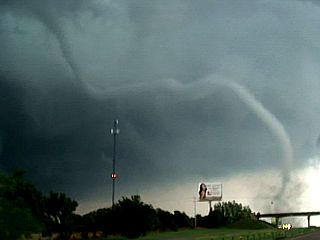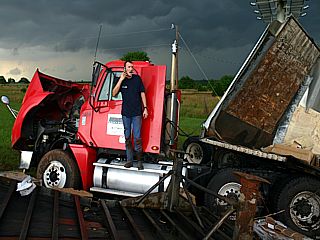Charles Kuster
EF4
This summer I spent ten weeks at the National Weather Service in Norman doing a research project and thought I would share some of the results here. The title of the project was An 11-Year Radar Based Study of Tornadic Thunderstorms Over Central Oklahoma and some of the major points are included below. More information can also be found on my website.
There were also two especially interesting cases that I came across on 5/10/10.

There is a tornado on the ground at the red circle, but there is essentially no storm present in reflectivity at any elevation scan. I do hesitate to call this a landspout, however, as the tornado was moving at 70mph. This is from Kingfisher, County.

This shows the Norman tornado and supercell, but there is another tornado located at the red circle. The tornado was on the ground for 20 minutes and was an EF2.
This is only a small amount of the information gathered during the 10 week project, but I hope some of it proves to be interesting!
- 126 tornadoes were looked at between 2000 and 2010 that were within 60 miles of KTLX.
- 104 tornadoes were produced by a supercell, 19 were produced by a QLCS, and 3 formed in a tropical environment (with the remnants of Erin).
- Radar characteristics were measured and a storm mode (i.e. supercell, QLCS, or tropical) was determined, using GR2Analyst, at the time of the initial tornado touchdown which served as a proxy for the mature stage of each thunderstorm.
- Radar characteristics include: storm width, storm height, low-level rotational velocity, mid level rotational velocity, mesocyclone width and height, and storm top divergence.
- Substantial differences did exist between the radar characteristics of supercells and QLCSs.
- This was especially obvious in mid level rotational velocity which was of all measured radar characteristics most correlated to tornado duration and F/EF rating.
- This was reflected by the fact that most QLCS tornadoes were weaker and briefer than most of the supercellular tornadoes.
- There were no strong correlations between any of the radar characteristics and Tornado-Warning lead time.
- This is likely due to the numerous variables present during the tornado warning process.
- There was a stronger correlation between storm mode and lead time likely due to the fact that sixty eight percent of the QLCS tornadoes were unwarned in this data set and lead time therefore set to "0 minutes."
- Injuries were not strongly correlated to lead time.
- Lead time should continue to be improved, but it is possible that researching other factors such as how the warnings are distributed to the public, call to action statements, and building construction standards would lower the number of injuries and deaths across the country.
- The data set provided a spectrum of radar characteristics for supercells.
- The spectrum was primarily linear and continuous suggesting that a distinct and separate storm category of "mini supercell" may not be able to be defined by using radar characteristics.
There were also two especially interesting cases that I came across on 5/10/10.

There is a tornado on the ground at the red circle, but there is essentially no storm present in reflectivity at any elevation scan. I do hesitate to call this a landspout, however, as the tornado was moving at 70mph. This is from Kingfisher, County.

This shows the Norman tornado and supercell, but there is another tornado located at the red circle. The tornado was on the ground for 20 minutes and was an EF2.
This is only a small amount of the information gathered during the 10 week project, but I hope some of it proves to be interesting!
Last edited by a moderator:


